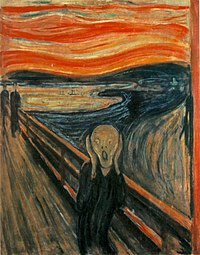
Photo from wikipedia
Importance It is critical to evaluate the risk of comorbid psychiatric diagnoses to meet the needs of individuals with autism spectrum disorder (ASD). Objective To examine whether individuals with ASD… Click to show full abstract
Importance It is critical to evaluate the risk of comorbid psychiatric diagnoses to meet the needs of individuals with autism spectrum disorder (ASD). Objective To examine whether individuals with ASD are at greater risk for comorbid diagnoses of depression, anxiety, or bipolar disorder. Design, Setting, and Participants This cohort study used data from a population-based birth cohort of 31 220 individuals born in Olmsted County, Minnesota, from January 1, 1976, to December 31, 2000. Patients with research-identified ASD were previously identified using a multistep process that evaluated signs and symptoms abstracted from medical and educational records. For each of the 1014 patients with ASD, 2 age- and sex-matched referents who did not meet criteria for ASD were randomly selected from the birth cohort (n = 2028). Diagnosis codes for anxiety, depression, and bipolar disorders were electronically obtained using the Rochester Epidemiological Project records-linkage system. Data analysis was performed from July 1, 2018, to April 1, 2019. Main Outcomes and Measures Cumulative incidence of clinically diagnosed depression, anxiety, and bipolar disorder through early adulthood in individuals with ASD compared with referents. Results A total of 1014 patients with ASD (median age at last follow-up, 22.8 years [interquartile range, 18.4-28.0 years]; 747 [73.7%] male; 902 [89.0%] white) and 2028 referents (median age at last follow-up, 22.4 years [interquartile range, 18.8-26.2 years]; 1494 [73.7%] male; 1780 [87.8%] white) participated in the study. Patients with ASD were significantly more likely to have clinically diagnosed bipolar disorder (hazard ratio [HR], 9.34; 95% CI, 4.57-19.06), depression (HR, 2.81; 95% CI, 2.45-3.22), and anxiety (HR, 3.45; 95% CI, 2.96-4.01) compared with referents. Among individuals with ASD, the estimates of cumulative incidence by 30 years of age were 7.3% (95% CI, 4.8%-9.7%) for bipolar disorder, 54.1% (95% CI, 49.8%-58.0%) for depression, and 50.0% (95% CI, 46.0%-53.7%) for anxiety. Among referents, cumulative incidence estimates by 30 years of age were 0.9% (95% CI, 0.1%-1.7%) for bipolar disorder, 28.9% (95% CI, 25.7%-32.0%) for depression, and 22.2% (95% CI, 19.3%-25.0%) for anxiety. Conclusions and Relevance The findings suggest that individuals with ASD may be at increased risk for clinically diagnosed depression, anxiety, and bipolar disorder compared with age- and sex-matched referents. This study supports the importance of early, ongoing surveillance and targeted treatments to address the psychiatric needs of individuals with ASD.
Journal Title: JAMA pediatrics
Year Published: 2019
Link to full text (if available)
Share on Social Media: Sign Up to like & get
recommendations!